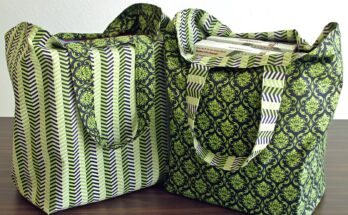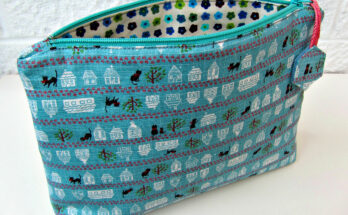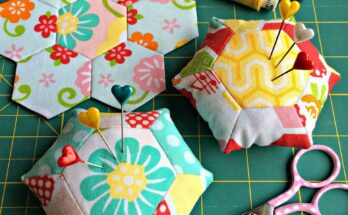The DIY fashion world has a dirty little secret: no care labels! You’ve poured your heart, soul, and probably a fair amount of money into creating that perfect garment. It fits like a dream, looks stunning, and you’re proudly showing it off to the world. But there’s a tiny detail missing – the care label. You know, that little tag that usually gets ignored until you accidentally shrink your favorite dress into doll-size.

Now you’re left playing a guessing game every time laundry day rolls around. Will your lovingly crafted creation emerge from the wash looking like a masterpiece or a dishrag? You see, the absence of a few square inches of fabric – the label – can cause existential dread.

Welcome to the thrilling world of care label-less clothing, where every wash cycle is an adventure and your laundry basket is a mystery box of potential disasters waiting to happen.
My journey through the labyrinth of fabric care has been nothing short of a comedy of errors. I’ve shrunk cottons and silks to kid-size proportions, turned my bright linen outfits into wrinkled, tie-dyed disasters, and created enough lint from rayon to stuff a small pillow. Let’s not even talk about the time I accidentally melted my polyester blouse into modern art (it wasn’t pretty).
And don’t get me started on silk – I swear those wrinkles appear if you so much as look at it funny. As for wool, well, let’s just say I’ve inadvertently created some very fashionable (and very tiny) clothes for my dog.
But I’ve emerged from the trenches of laundry mishaps wiser, if a bit more paranoid about washing machines. In this article, I’m going to share my hard-earned wisdom to help you avoid turning your beautiful handmade creations into avant-garde fabric experiments. So, get ready for some tips that’ll save your handmade items from the perils of improper care.
Ah, and before you tell me “but you made it, you know what’s inside” – I sometimes don’t remember what I ate yesterday. Just so we know where we are. Moreover, the original fabric probably didn’t have a care label either.
Actually, there are labels on fabric bolts. Here is one. So yes, these mythical creatures do exist, lurking on the ends of fabric bolts, teasing us with their brief snippets of wisdom.

But let’s be real, who among us hasn’t played the “I’ll definitely remember this care info” game, only to find ourselves staring blankly at our fabric stash weeks later?
Sure, you could try to be a responsible sewist and snap a quick pic with your phone. But those photos have a magical way of disappearing into the void of your camera roll, never to be seen again. They’re probably hanging out with all those “important” screenshots you swore you’d look at later.
And also, these labels often leave us more puzzled than enlightened. “Wash cool, tumble dry low” – thanks, that narrows it down to… most of my wardrobe.
So, while these labels exist in theory, in practice, they’re not really helpful.
This is why we’re here, sharing our hard-earned wisdom and laundry battle scars. Who needs official care labels when you’ve got a community of fellow sewists ready to commiserate and problem-solve? Together, we’ll decode the mysteries of fabric care, one sudsy adventure at a time.
Tip #1: Know Your Fabric, or the Sherlock Holmes Approach to Laundry Day

Before you toss that handmade masterpiece into the washing machine, it’s time to play fabric detective. Knowing your fabric is the key to proper care so you can avoid turning your favorite creations into unwearable disasters.
It’s tempting to play it safe and wash everything… but everything on “delicate” in cold water, but that’s not always the best approach. Your handmade items deserve tailored care to keep them looking their best. Let’s break it down.
Sturdy cotton and linen fabrics can handle hot water and regular wash settings. But don’t toss everything in together. Sort by color to avoid turning your white shirt into an accidental tie-dye experiment.
To prevent any sneaky color bleeding, use color catcher sheets – they will trap loose dyes before they can cause chaos.
And for those extra special pieces? Tuck them into mesh bags.
Also, just because your cotton or linen fabric can take the heat doesn’t mean it should. For everyday washes, warm water often does the trick and is gentler on your clothes in the long run. And cheaper, too. Save the hot water for when your garments have had an encounter with a particularly enthusiastic mustard bottle or mud puddle.
Made delicate garments from natural silk? Everybody recommends hand washing, but I’ve discovered a nifty trick: the salad spinner method. Did you know that your lunch prep gadget could moonlight as a fabric savior? You can read all about these silk-specific solutions in my article How to wash and prewash silk fabric – your silky smooth guide to handling this luxurious yet tricky material.
Just pop your garment in with cold water, give it a whirl, and voila! Clean silk garment without the hassle. No dryer for these delicate beauties, though. Instead, roll them in a fluffy bath towel.
Always consider ALL the fabrics in your garment. Let me tell you about my wool skirt fiasco. So, I made a wool skirt (very thin 100% wool) with a silk lining. Sounds harmless, right? I tossed it in for a cold, gentle machine wash, feeling rather good about my fabric care skills. The result? The wool threw a shrinking tantrum while the silk stood its ground. Suddenly, I was an unwitting participant in extreme garment reconstruction.
Wool – oh, wool. It’s the drama queen of the fabric world. I’ve seen more wool items shrink faster than my bank account, even with cold water and delicate cycles. They easily turn into felt. For my handmade wool coats, jackets, and skirts, I’ve become best friends with the dry cleaner – they come back unshrunk. Yes, it costs more, but at least my garments still fit.
As for polyester, it’s usually the low-maintenance friend of the fabric world. You can usually toss it in the washer without much fuss. But beware the heat. Stick to cool or warm water, and for drying, either hang it up or use low heat.
There’s a whole universe of fabrics out there, each with its own quirks and care needs. Trying to cover them all in one article would be like attempting to cram an entire fabric store into a clutch purse – it’s just not going to happen.
But here’s the golden nugget of wisdom: know your fabric and treat it right. It’s the difference between a wardrobe that lasts and one that ends up as a pile of misshapen, faded memories. Each type of fabric has its own personality and needs – some are tough as nails, others are delicate flowers.
The key is to do a bit of homework before you start putting things in the wash. A quick internet search or a chat with your fellow sewing enthusiasts can save you from a laundry disaster. It might seem like a hassle, but it’s way less work than trying to un-shrink a wool skirt or de-wrinkle a crumpled silk blouse.
Your handmade creations deserve the same care you put into making them. A little fabric knowledge goes a long way in keeping your wardrobe looking fabulous.
Tip #2. Prewashing or Your Fabric’s Sneak Peek at Laundry Life

Let’s talk prewashing – that crucial step many sewists skip but shouldn’t. Why bother, you ask? Well, imagine finishing a project only to have it shrink, warp, or bleed colors after its first wash. Not exactly the grand finale you had in mind for your handmade masterpiece.
Prewashing is your fabric’s trial run. It reveals the true colors (literally) of your material before you invest hours in cutting and stitching. Some fabrics shrink, others bleed dye, and a few might even change texture. Better to discover these quirks before they become permanent features of your finished garment.
But it’s not just about preventing disasters. Prewashing can also improve your fabric’s quality. It often softens the material, making it more pliable and comfortable to wear. Plus, it removes any residual chemicals or excess dye, giving you a clean slate to work with.
Sure, it adds an extra step to your sewing process. But consider it an investment in your project’s longevity. A few minutes of prep work can save you from hours of frustration later.
So next time you’re itching to dive straight into cutting that new fabric, pause and consider giving it a wash first. For more detailed tips on how to prewash different types of fabric, check out my comprehensive guide on prewashing.
While prewashing is usually beneficial, it’s not a one-size-fits-all solution. Some fabrics actually prefer to skip this step. Thin wool, for instance, should avoid the prewash treatment. Instead, I use my iron to gently preshrink it, giving it just enough heat to prevent future surprises without compromising its delicate structure.
Natural silk charmeuse or chiffon are also members of the no-prewash club in my sewing room. For these fabrics, I use patterns that aren’t too form-fitting. This way, if there’s a bit of shrinkage after the first wash, it’s hardly noticeable and doesn’t affect the overall fit.
For most other fabrics, prewashing remains a crucial step. Knowing when to prewash – and when not to – is just as important as the process itself. It’s all part of understanding your fabric’s unique personality and needs.
Tip #3. Customize Your Care – Because Your Handmade Clothes Are One of a Kind
Handmade garments are like snowflakes – no two are exactly alike. Each piece is a unique creation, often featuring special fabrics, intricate embellishments, delicate embroidery, or innovative construction techniques. These distinctive features are what make your handmade clothes special, but they also mean that off-the-rack care instructions just won’t cut it.
Your embroidered cotton blouse might need different treatment than your cotton t-shirt. That sequined party dress? It definitely can’t be tossed in with your everyday laundry. And let’s not even get started on that lace skirt with the hand-sewn beading.
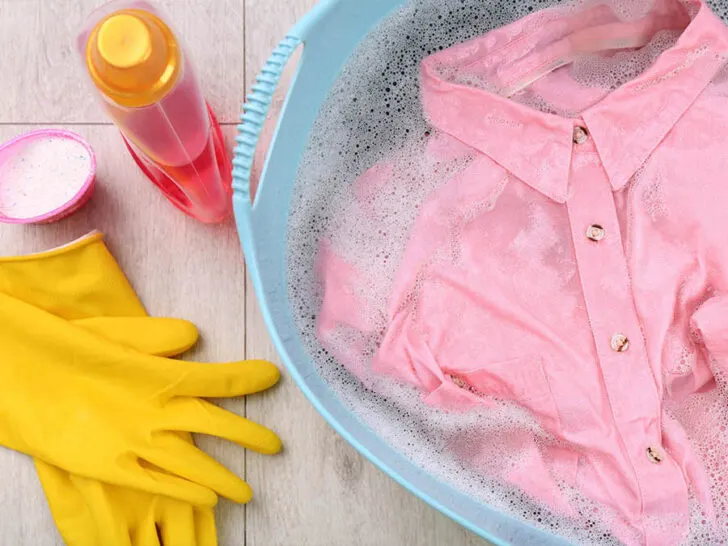
The key is to assess each garment individually. Consider the fabric, the embellishments, and the construction. Are there delicate trims that could come loose in a regular wash cycle? Are there crystals that might not survive a spin in the dryer? Does the fabric need special handling to maintain its texture or sheen?
Sometimes, this might mean hand-washing certain items, even if it’s a bit more time-consuming. Other times, it could involve using specialized cleaning products or techniques. And yes, occasionally it might mean a trip to a professional cleaner who can give your prized creation the expert care it deserves.
The extra effort you put into caring for your handmade clothes is an extension of the love and creativity you poured into making them. By giving each piece the individualized care it needs, you’re ensuring that your handmade wardrobe stays beautiful and wearable for years to come.
Tip #4. Less Washing, More Wearing – The Handmade Clothing Longevity Secret

Let’s talk about a little-known perk of your handmade wardrobe: it’s not as needy in the laundry department as its store-bought cousins. While your everyday t-shirts and jeans might be begging for a wash after every wear, your lovingly crafted pieces often have different needs.
Think about it – you’re not whipping up run-of-the-mill hoodies or t-shirts. Those items are a dime a dozen at the mall. No, you’re creating unique, higher-quality garments that deserve special treatment. That silk blouse you spent weeks perfecting? It doesn’t need to hit the laundry basket after every wear. Your hand-tailored wool trousers? They can go quite a while before requiring cleaning.
This isn’t just good news for your water bill and free time. Less frequent washing is actually a secret weapon for extending the life of your handmade clothes. Every trip through the washing machine puts stress on fabrics and seams. By reducing these laundry adventures, you’re preserving the quality, color, and shape of your creations.
Of course, this doesn’t mean ignoring stains or odors. Use your judgment. But a quick spot clean or airing out can often freshen up a garment without subjecting it to a full wash cycle.
Your handmade pieces are special. They’re not mass-produced to withstand industrial washing processes. By treating them with a little extra care and reducing unnecessary washes, you’re ensuring they’ll remain stunning pieces in your wardrobe for years.
Tip #5. Stain Showdown – Swift Action Saves the Day
Stains are like the arch-nemesis of every beautiful garment, handmade or not. But when it comes to your lovingly crafted pieces, treating stains promptly isn’t just helpful, it’s crucial.
So, let’s say, you’re wearing your latest creation, a stunning linen dress with intricate embroidery, when disaster strikes in the form of a rogue splash of red wine. Your heart skips a beat, but don’t panic! This is where your lightning-fast reflexes come into play.
The longer a stain sits, the more it sets, and the harder it becomes to remove. With a store-bought t-shirt, you might shrug and say, “Oh well, it was cheap anyway.” But with your handmade masterpieces? No way! Each item is a labor of love, and deserves your immediate attention.
Keep a stain removal kit handy – think of it as your utility belt in this battle against blemishes. A few key items like a stain remover stick, white vinegar, and baking soda can work wonders if applied quickly.
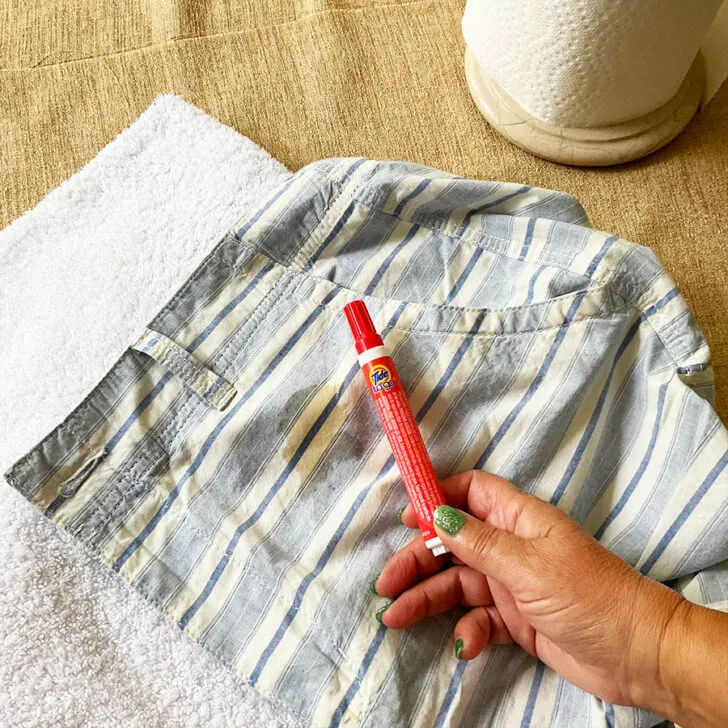
✅ Related tutorial: How To Remove Coffee Stains From Clothes: Ultimate Guide
Different fabrics and different stains require different treatments. That wine stain on linen won’t react the same as an oil spot on silk. Do a quick internet search if you’re unsure – it’s better to take a moment to double-check than to accidentally set the stain permanently.
By tackling stains as soon as they happen, you’re not just cleaning a spot – you’re preserving your hard work, creativity, and the unique beauty of your handmade wardrobe.
Tip #6. Knits vs. Wovens – Tailoring Care for Your Handmade Creations
When it comes to your handmade garments, the divide between knits and wovens is important.
For your lovingly crafted knit items – be it that perfect t-shirt dress or that cozy cardigan you spent weeks making – preserving their shape and stretch is key. You want them to keep their huggable qualities. Wash them gently in cool water, avoid any harsh agitation that could distort the knit texture. When it’s time to dry, resist the urge to hang them up. Instead, lay them flat, gently reshaping if needed. This prevents gravity from pulling your creation into an unintended long and lean look.
✅ Related tutorial: All About Sewing Knit Fabric
Your handmade woven garments have different needs. They’re all about maintaining crisp lines and precise fit. While they can generally handle a bit more in terms of washing, be mindful of seams and interfacings you’ve so carefully constructed. Hang these items to dry to help maintain their shape, but be sure to use padded or shaped hangers to avoid shoulder bumps.
Tip #7. The Great Dry-Off – Keeping Your Handmade Creations in Shape
Drying your handmade garments isn’t just about getting them from wet to wearable. After all, you didn’t spend hours crafting the perfect piece just to have it warp into an unrecognizable shape during the drying process.
First things first: often it’s better to step away from the dryer. While that tumbling machine is great for your everyday t-shirts, towels, and bed linen, it’s often too harsh for your handmade treasures. High heat can shrink fabrics, damage delicate embellishments, and wear out fibers faster.
Instead, embrace air drying. Grab those hangers or a drying rack and let nature do its thing. You’ll also save money and the air dried garments will have that fresh smell we remember from when we were young. Of course, beware of pollution – not all environments are clean and I have seen garments freshly washed needing a wash again after drying.

For most knit garments, laying flat is the way to go. Use a clean, dry towel as a base, and carefully shape your item as it dries.
Woven items often benefit from hanging to dry. Some delicate items, like silk blouses or embellished pieces, might prefer a hybrid approach. Start by laying them flat until they’re damp, then finish with a brief hang to release any wrinkles.
Sometimes, despite our best intentions, we find ourselves face-to-face with the dryer. Maybe it’s raining outside, or perhaps you need that handmade dress dry ASAP for a hot date. Whatever the reason, if you must use the dryer, treat it with caution.
Low heat is your friend. High heat can shrink, warp, and generally turn your masterpieces into mini versions of themselves.
Don’t let the dryer have the last laugh. Snatch your items while they’re still slightly damp. Plus, this little trick can help reduce wrinkles.
And let’s not forget about static cling – unless you enjoy that “stuck-to-you” look. To avoid this, toss in a few wool dryer balls. They will keep clothes separated and static-free.
Using the dryer on your handmades should be the exception, not the rule.
Tip #8. Suds and Sensibility – The Art of Gentle Cleansing

Choosing the right detergent is like picking the perfect fabric – it can make or break your creation.
Ditch those harsh, industrial-strength detergents. They might be good for a mechanic’s overalls, but your handmade treasures deserve better than a chemical cocktail that could strip them of their charm. Choose a gentle, pH-neutral detergent.
Now, here’s a common pitfall: the “more is better” mentality. It’s tempting to pour in extra detergent, thinking it’ll get your clothes extra clean. No, it won’t. In fact, too much detergent can leave a residue on your fabrics, making them stiff and potentially irritating your skin. Also, if you use too much detergent, you’ll be rinsing forever. A little goes a long way. Use just enough to get the job done.
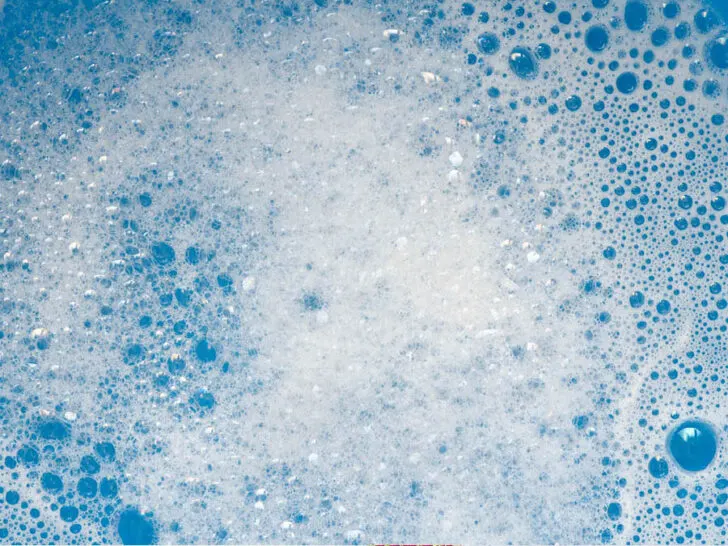
Here’s a tip that might surprise you: use baby shampoo. For those ultra-delicate items baby shampoo can be a gentle yet effective cleaner. It’s designed for sensitive skin, so you know it’ll be kind to your precious handmades.
The goal isn’t just to clean your garments, but also to preserve the love and effort you poured into making them.
Tip #9. Testing for Colorfastness – Taming Rebellious Dyes
You know you can check if your fabric’s dye will bleed. This is especially important for vibrant colors or prints.
To test, cut a small swatch of fabric. Wet it and press them together like you’re making a fabric sandwich. If your white clothes come away looking like they’ve had a dye job, congratulations! You’ve caught a color criminal in the act.
For these color-bleeding bandits, you have a few options:
- Wash them alone in cold water. They can’t taint what isn’t there.
- Use color catcher sheets – they trap loose dyes before they can cause chaos.
- Give them a gentle hand wash.
- Sometimes, dry cleaning is the safest bet. Let the experts handle your rebellious hues.

This little test is like a crystal ball for your sewing projects. It can save you from big, colorful surprises down the road. After all, the only bleeding we want in our sewing room is from accidental pin pricks. Well, we don’t want those either, but it’s a fact of life.
Tip #10. High-Tech Helpers – Modern Marvels for Fabric Care
Laundry technology has come a long way. It offers some fantastic tools to help care for your handmade garments. Here’s a list of modern, high-quality items that can elevate your fabric care routine.
Note: Some of the links on this page are affiliate links. This means I will receive a commission if you order a product through one of my links. I only recommend products I believe in and use myself.
Wool dryer balls. Replace chemical-laden dryer sheets with these natural, reusable alternatives.

Wool Dryer Balls – Natural Fabric Softener
Portable washers. Perfect for delicate items or quick stain removal on the go.

Color-catching sheets. These prevent color bleeding in mixed loads, protecting your carefully chosen fabric colors.

Shout Color Catcher Sheets for Laundry
Fabric shavers. Remove pilling and keep your knits looking fresh.

Conair Fabric Shaver and Lint Remover
Steamer. A gentler alternative to ironing, great for delicate fabrics and removing wrinkles without direct heat.

Specialized detergents. Look for enzyme-based cleaners or those designed for specific fabrics like wool or silk.

Heritage Park Silk & Wool Spring Magnolia Floral Scent, pH-Neutral Laundry Detergent
Stain-removing pens. For quick action on unexpected spills.

Tide Stain Remover for Clothes
Mesh laundry bags. Protect delicate items during machine washing.

BAGAIL Laundry Bag Mesh Wash Bag
Drying racks with adjustable arms. Allow for customized air-drying setups.

At-Home Dry Cleaners. It takes about 20 minutes to complete in your dryer.

Did you like this guide? Well, don’t let it slip away like that sock that mysteriously vanishes in the dryer. Grab that pin below and stick it on your fabric board on Pinterest. And while you’re in a pinning mood, why not follow me on Pinterest? It’s like subscribing to a never-ending show of sewing tips, tutorials, and enough inspiration to make your sewing machine purr with excitement. Your feed will be so full of creative ideas, you’ll be itching to start your next project before you’ve even finished reading.


